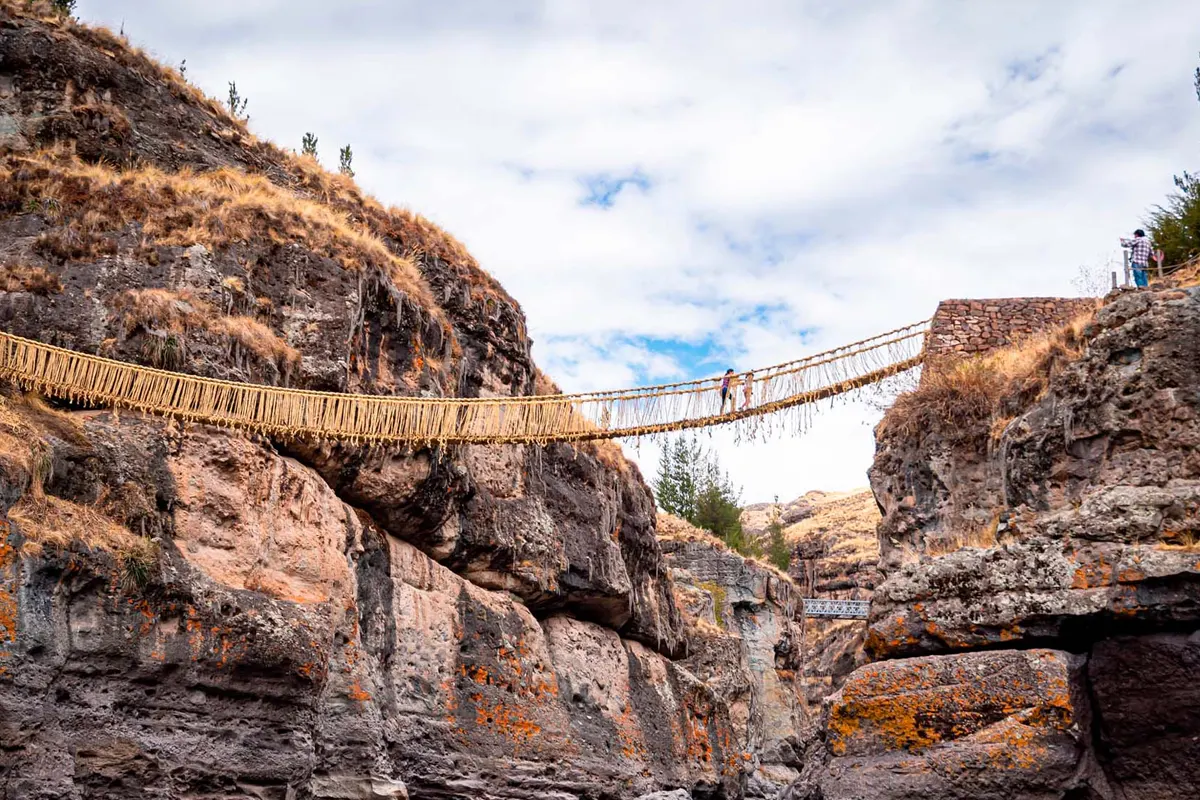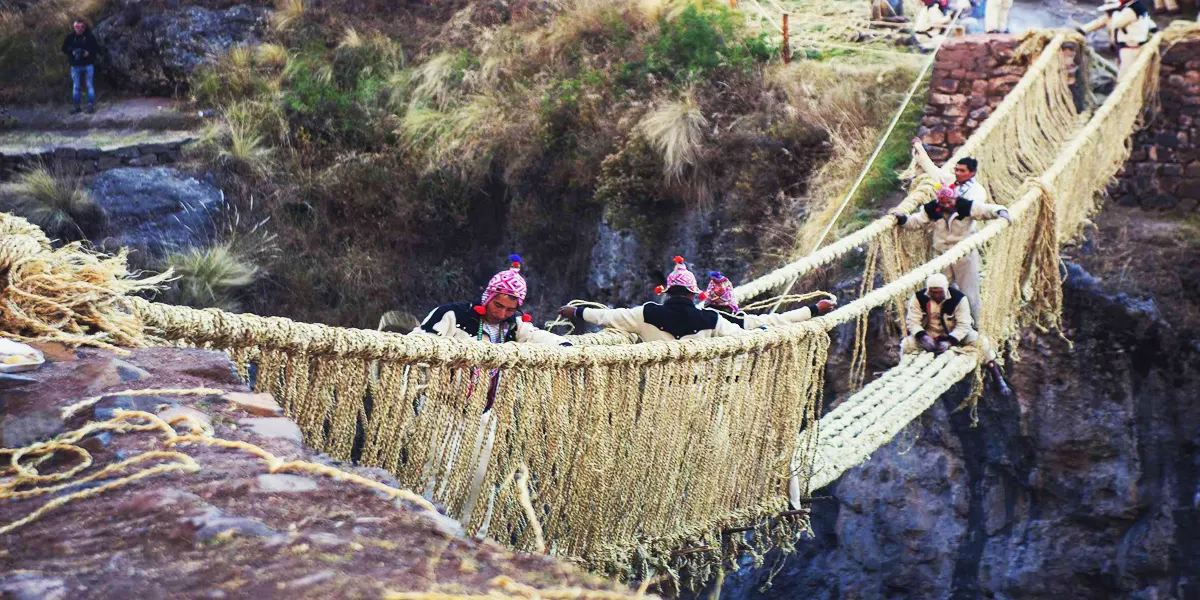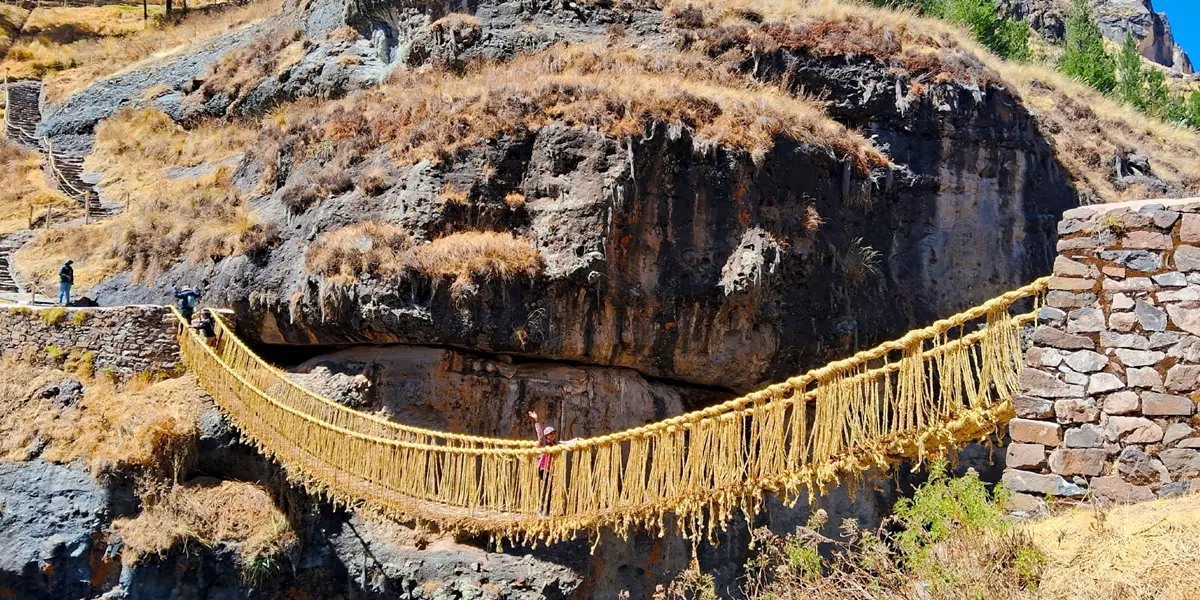Q’eswachaka: The Inca Bridge of Cusco

Q’eswachaka
The Q’eswachaka Bridge is the last of its kind: a living relic of the Inca civilization’s brilliance in engineering and community construction. Rebuilt annually using ancestral techniques, this extraordinary Inca rope bridge remains a vital symbol of cultural identity and artisan skill. For those passionate about history, tradition, and authenticity, Q’eswachaka is an essential experience.
What Exactly Is the Q’eswachaka Bridge?
The Q’eswachaka Bridge is an authentic Inca-style suspension bridge located in the remote district of Quehue, within the province of Canas, in southern Peru. This handmade structure spans the powerful Apurímac River and is made entirely from natural resources such as qoya ichu, rawhide, and wood. Without modern tools, the bridge’s construction demonstrates the extraordinary skills inherited from Inca ancestors and preserved through generations.
A Ritual of Strength and Unity: Rebuilding Q’eswachaka

Rebuilding of Q’eswachaka
Every June, the communities of Huinchiri, Chaupibanda, Choccayhua, and Ccollana Quehue gather to rebuild the bridge using traditional knowledge passed down for over six centuries. This annual event is not only practical but also deeply spiritual and communal.
Step by Step: How the Bridge Is Rebuilt
The reconstruction is a four-day ritual that blends engineering with ceremony:
- Day 1 – Spiritual Opening and Material Gathering: The ritual begins with a sacred offering to the Apus, the mountain deities. Women from the communities collect and braid ichu grass into ropes, a vital step in the process.
- Day 2 – Dismantling the Old Bridge: Community members carefully take down the worn bridge, recycling materials and beginning to braid new structural ropes.
- Day 3 – Weaving the New Structure: Men suspend thick ropes across the canyon and interlace the floor and railings, carefully building the bridge under challenging conditions.
- Day 4 – Completion and Celebration: Once the bridge is finished and safety-tested, a lively celebration follows, with music, food, and dance uniting the communities.
Why Q’eswachaka Remains So Important
Beyond its impressive appearance, the bridge represents resilience and identity:
- Organic Engineering: Completely built from sustainable Andean materials, Q’eswachaka showcases nature-based engineering perfected over generations.
- Heritage in Motion: This is not just a relic; it’s a living tradition. Each year, locals don’t just honor their history—they live it.
- A Symbol of Connection: The bridge physically connects two riverbanks but metaphorically connects past and present, humans and nature, tradition and resilience.
Traveling to Q’eswachaka: An Immersive Cultural Adventure

Inca Bridge – Qeswachaka
How to Get There
Located about four hours south of Cusco, the Q’eswachaka Bridge is nestled in a remote Andean landscape. There is no public transportation available, so most travelers opt for a guided tour or private transport. The journey includes a mix of paved and unpaved roads, offering panoramic views of the Peruvian Andes along the way.
What to Expect Onsite
Upon arrival, visitors are greeted with dramatic views of the Apurímac River canyon and the towering Andes Mountains. You can walk across the handmade bridge, admire its construction up close, or simply enjoy the landscape. If you arrive during the June reconstruction period, you can witness the impressive communal effort that brings it back to life.
Why Visit Q’eswachaka?
- Historical Depth: Walking across this Inca bridge offers a rare opportunity to physically engage with an Inca legacy that’s still alive today.
- Cultural Connection: Visiting during the reconstruction ceremony gives travelers insight into how ancestral traditions remain alive in modern Peru.
- Unmatched Views: The site is visually stunning—perfect for photography, reflection, and learning about the Andean environment.
Experience Q’eswachaka with Travels to Machu Picchu
For a meaningful and well-guided journey to Q’eswachaka, consider joining an organized experience with Travels to Machu Picchu. Our immersive tours ensure you not only visit the bridge but also gain a deeper understanding of its cultural roots, the communities that sustain it, and the incredible landscape that surrounds it. With expert local guides, your visit becomes a story worth remembering.
Bridge Construction Timeline: A Closer Look
| Day | Activity | Details |
|---|---|---|
| Day 1 | Spiritual Ceremony and Preparation | A ritual offering to the Apus begins the process. Women prepare the ichu and other natural materials. |
| Day 2 | Bridge Dismantling | The old bridge is taken apart, and new ropes are braided using ancestral techniques. |
| Day 3 | Assembly Over the River | With ropes secured, the bridge structure is hand-built, suspended over the Apurímac canyon. |
| Day 4 | Completion and Festivity | The bridge is tested and blessed. A celebration marks the achievement with food, dance, and shared joy. |
Final Thoughts: A Heritage That Spans Centuries
Q’eswachaka is more than an old bridge—it’s a living symbol of how culture, nature, and community intertwine in the Andes. Rebuilt each year with unwavering commitment, this bridge continues to inspire awe and appreciation for the resilience of Peru’s Indigenous traditions.
Whether you’re seeking cultural depth, ancestral engineering, or a unique travel story, Q’eswachaka delivers it all. Don’t miss the chance to walk across a structure that not only connects two riverbanks but also links you to a timeless legacy.






